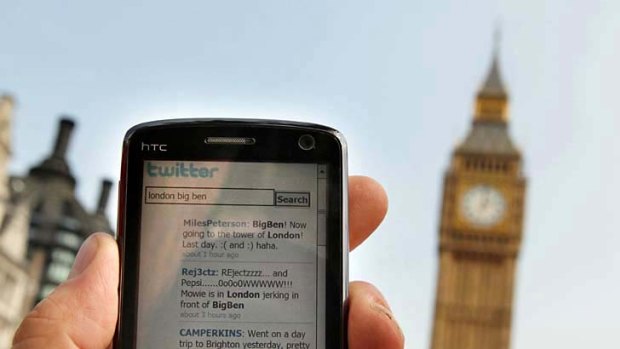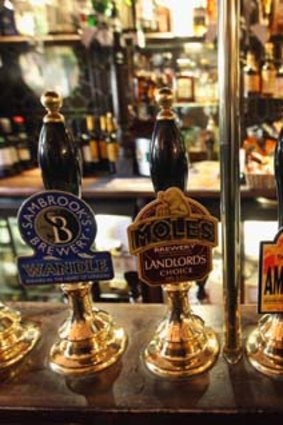
Tweet trip ... London by Twitter.Credit: Getty Images
In London without plans or firm bookings, David Whitley lets the twittering masses take him on a city adventure.
I SHALL never again accuse my mother of keeping a cluttered house. She's got nothing on Sir John Soane, for whom seemingly no corner is above having another souvenir shoved into it.
His souvenirs are a little more impressive than most - he's been around Europe and the Mediterranean pilfering antiquities. Bits of the Acropolis here, a sarcophagus from the Valley of the Kings in Egypt there, plus Roman treasures almost tumbling over each other.
Sir John Soane's Museum is a gloriously eccentric spot in central London and I wouldn't have known it existed without Twitter user @rowenanews. It wasn't the only cherished new find of the day, either.
Due to the way my flights worked out, I had a day and night in London before taking off early the next morning. It's a city I'd been to a few times and one where I'd ticked off most of the big attractions. So this time I decided to conduct an experiment. I organised nothing, booked nothing and, using my mobile phone, followed any suggestions received from Twitter on the day.
I'd not expected too much from my gamble but as soon as I put out the request for ideas, a wave started coming in; people I didn't know started tipping their favourite London secrets. All manner of beauties came up - the only Nazi grave in London, numerous cemeteries, Inuit art exhibitions, you name it.

Ales at The Harp.Credit: Getty Images
Most intriguing among them was @hackneye's pick, the Memorial to Heroic Self-Sacrifice. Just to the north of St Paul's Cathedral is a blink-and-you'll-miss-it park of numerous churchyards.
Postman's Park is a wonderfully peaceful spot in which to munch on your lunchtime sandwiches but it's the shelter set up by the Victorian artist, George Frederic Watts, that provides the quirk.
The memorial is essentially a wall covered in porcelain tiles. Each has a tribute on it, honouring someone who gave their life to help someone else. It's a moving mosaic of tragic heroism, hinting at stories of rescues from burning buildings and frozen canals that would otherwise go unremembered. It's a warm, poignant oddity that bolsters your faith in the human spirit.
As I headed towards my next tip, I was given a diversion. @501places and @hackneye concurred over Twitter and cryptically suggested "the amphitheatre under the Guildhall". The Guildhall Art Gallery is rather ho-hum but I'm enormously glad it's there. During the construction, excavation teams stumbled across ruins deep below street level, the remnants of a Roman amphitheatre, a nearly 2000-year-old arena that hosted gladiatorial combat and executions in the early days of what was then known as Londinium.
Rubbly foundations remain and original drains are kept under a glass walkway. It's the new additions that make this subterranean quirk, however - projected light against reflective tape on the walls shows human outlines engaging in sporting endeavour, with the back wall offering a 2D representation of what the amphitheatre would have looked like during the Roman era.
I finally got to @lewisshields' submission in the mid-afternoon. I'd not held out much hope for the Museum of London Docklands - after all, how exciting can the history of port operations in London be? But I ended up wishing I'd got there earlier. It contains an absorbing collection of topics - ranging from the uses of the River Thames to the slave trade -
tied together by a loose theme. One minute you're learning about whaling off the coast of Greenland, the next you're walking through a reconstruction of a street from the port's 18th-century heyday.
In truth, I had been given enough ideas to keep me occupied for days. But accommodation proved to be more of a problem. The day before I arrived, I put out an appeal for recommendations.
I wanted somewhere to stay in central London for less than £100 ($155) a night and my initial tweet provoked a flood of more than 20 options. Many were along
"I stayed here but it's horrible" lines but others - particularly some stylish-looking new budget hotels and private members' clubs that rented spare rooms - looked excellent choices. One complete stranger even said I could crash on his sofa if needs be.
Alas, all the places I liked the look of were booked. I ended up, thanks to a somewhat clutching-at-straws @Dohop, at Dylan Kensington 109 near Earls Court. It cost £60 a night and I've paid much more for worse in London. By the city's budget-hotel standards, the apartment was reasonably spacious, if cheaply furnished and a little shabby, while the kitchenette would have been a handy bonus if I'd been staying longer. It screamed undemanding foreign-language-student chic but in the circumstances it was more passable than I had hoped for.
Where letting Twitter guide me really came into its own, however, was in terms of eating and drinking. For lunch, @edentravels sent me to Hummus Bros in Soho, which is somewhere between a cafe and a fast-food joint. Its slogan is "Give (chick) peas a chance" and the owners are trying to encourage people to think beyond the sandwich at lunchtime. Essentially, you get a bowl of hummus with a crater in the middle into which something else - chicken, fava beans, you name it - is slopped. I went for stewed beef and it was delicious.
Dinner's suggestion - courtesy of @davidchild - was an even bigger winner. Finding good, non-chain-store food in the heart of Theatreland is a tough ask, but Rossodisera is a jewel. A deli-restaurant run by two brothers from the Le Marche region of Italy, it has a rustic wood and exposed-brick look, a relaxed third-date feel and exceptional pasta dishes at bargain prices.
A short walk away is The Harp, in Covent Garden. According to @rtwflights, it does excellent beer. On hearing I was heading there, @andy_hoskins even chipped in with a drink recommendation. I was to try something by the Dark Star Brewing Co, apparently.
The Harp was clearly very popular. Patrons were spilling on to the street, pint glasses in hand in a rather untidy, un-British manner. Among them were @Malathronas and @stevenkeenan, who I know professionally and who had responded to my earlier shot-in-the-dark clarion call for drinking buddies. There was also @dom_stevenson, someone I don't know, had never met or had personal or professional links to. He'd seen my appeal for beery company and decided there was nothing to lose by joining a mini pub crawl with a motley bunch of strangers.
Twitter had provided numerous suggestions of nearby bars to head to next but we went with late arrival @john_oates's suggestion. De Hems is a Dutch pub, selling a range of Belgian beers. Most interestingly, it was the unofficial headquarters of the Dutch resistance during World War II.
Again, the Twitter experiment had turned up something about London that the guidebooks hadn't.
Getting up for the early flight next morning might have been hellish but the random night out - on top of an extremely random day - was unquestionably worth the gamble.
How to gather your tour guides and tips
WHAT you get out of Twitter depends on how you use it. If you sign up suddenly expecting the perfect travel agent, you're likely to be disappointed. If you regularly use it, have a decent number of followers and are generally quite generous with sharing your own tips, it can be extremely handy.
For this experiment, I was always going to have a better chance than most; I (@mrdavidwhitley) have been on Twitter for about 18 months and have almost 3000 followers.
A fair few live in London; a disproportionate number work in the travel industry.
But trying to sort it all out on the hoof is a massive gamble — as I discovered with accommodation.
A more sensible approach would be to scout around for tips a couple of weeks beforehand. You're almost certainly better off having the tips written down and marked on a map than being charged a fortune for data as you constantly use your phone to discover where everything is.
Depending on where your followers are and have visited, you'll have a lot more luck in some cities than others. Twitter will probably be more helpful for Perth and New York than Phnom Penh and Nairobi. Pick the right place, however, and you'll probably find people are unbelievably helpful.
They'll also guide you towards places that veer well beyond the obvious — Twitterers seem to want to share their discoveries and there's an element of showing off in picking places no one else has heard of.
For those relatively new to Twitter, one technique that can prove helpful is to track down local experts and message them directly. Most tourist boards have a Twitter account these days, as do listings magazines, hotel booking sites etc.
Ask directly and they'll tend to respond directly — hopefully with a good tip or two. They may even retweet your request to their followers.
Twitter's search facility can be handy, too. Put in the right keywords — "restaurant", "recommendation" and "San Francisco", for example — and any tweet featuring them in the last week will show up. You can find other people who were looking for the same advice, then follow through and see what responses they got.
Sign up for the Traveller Deals newsletter
Get exclusive travel deals delivered straight to your inbox. Sign up now.